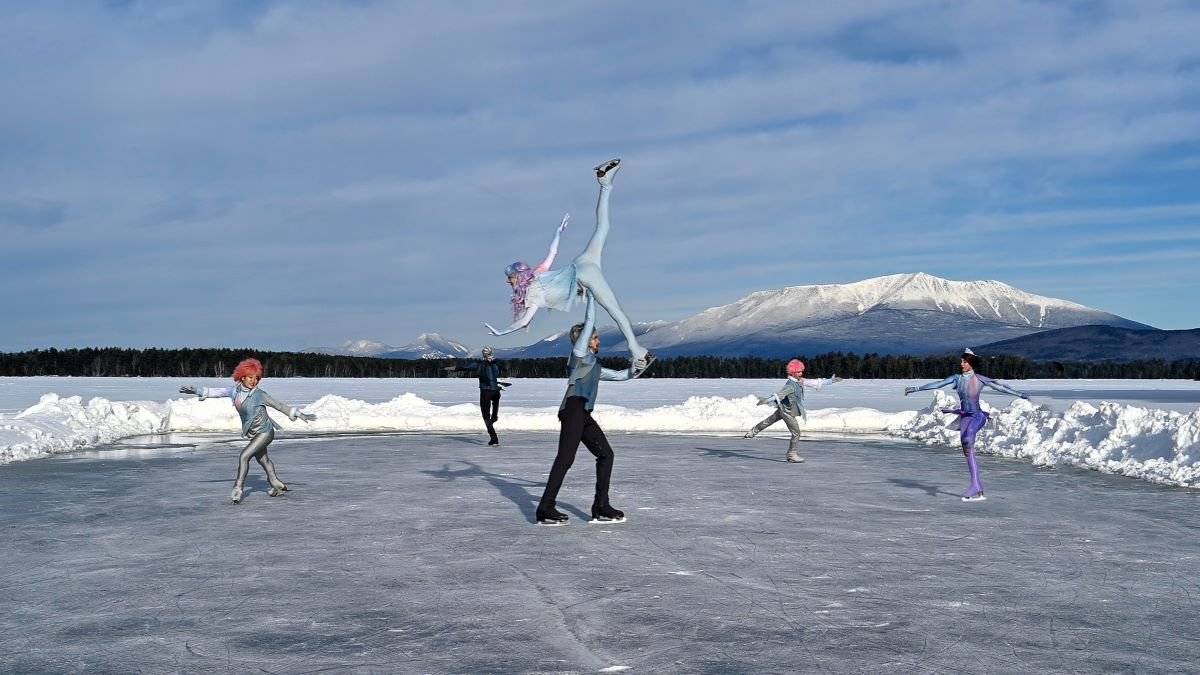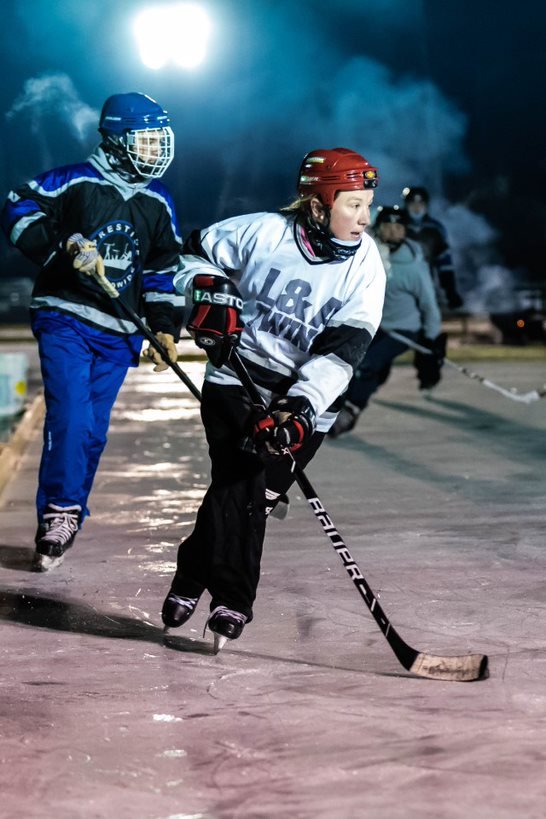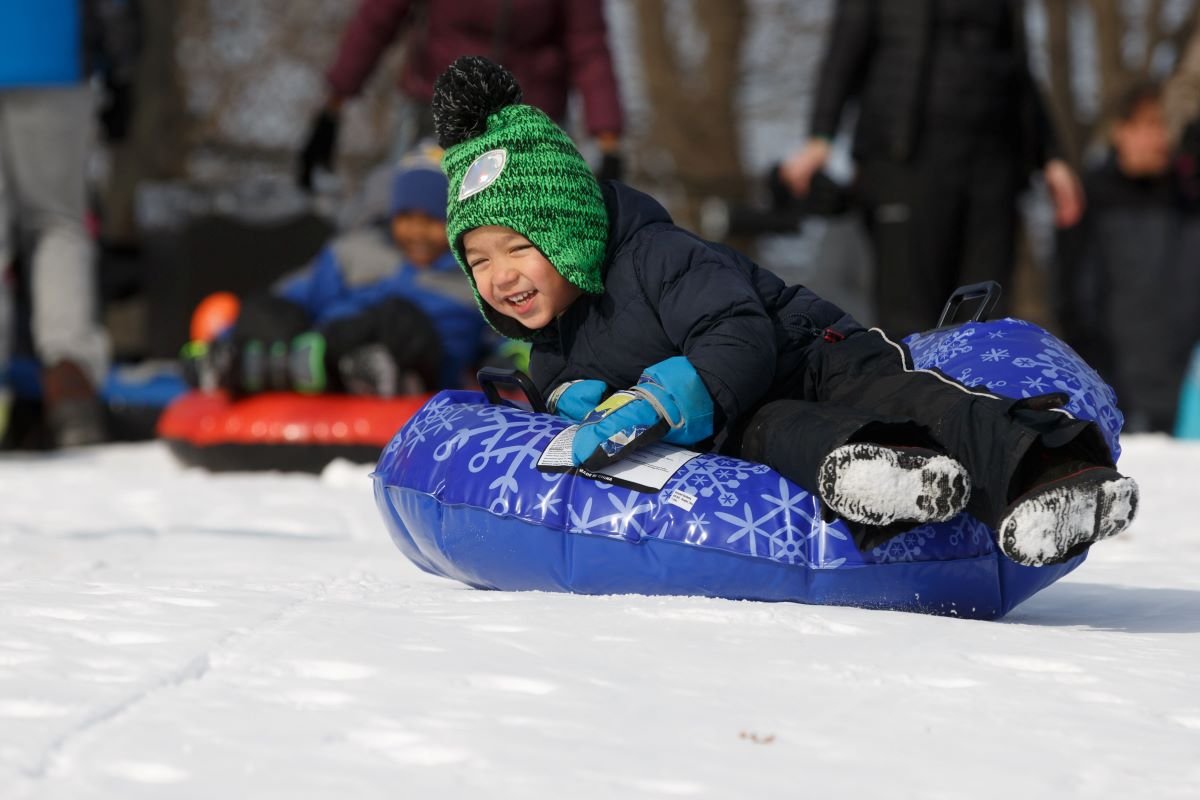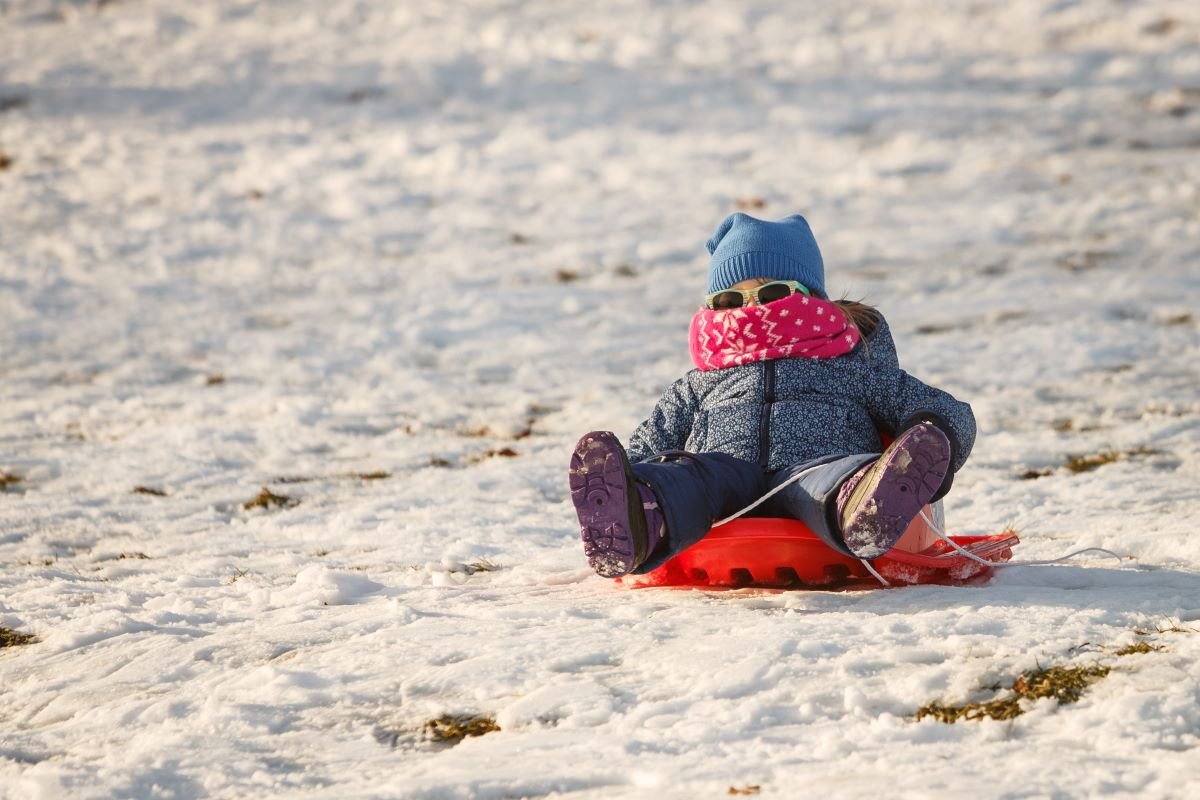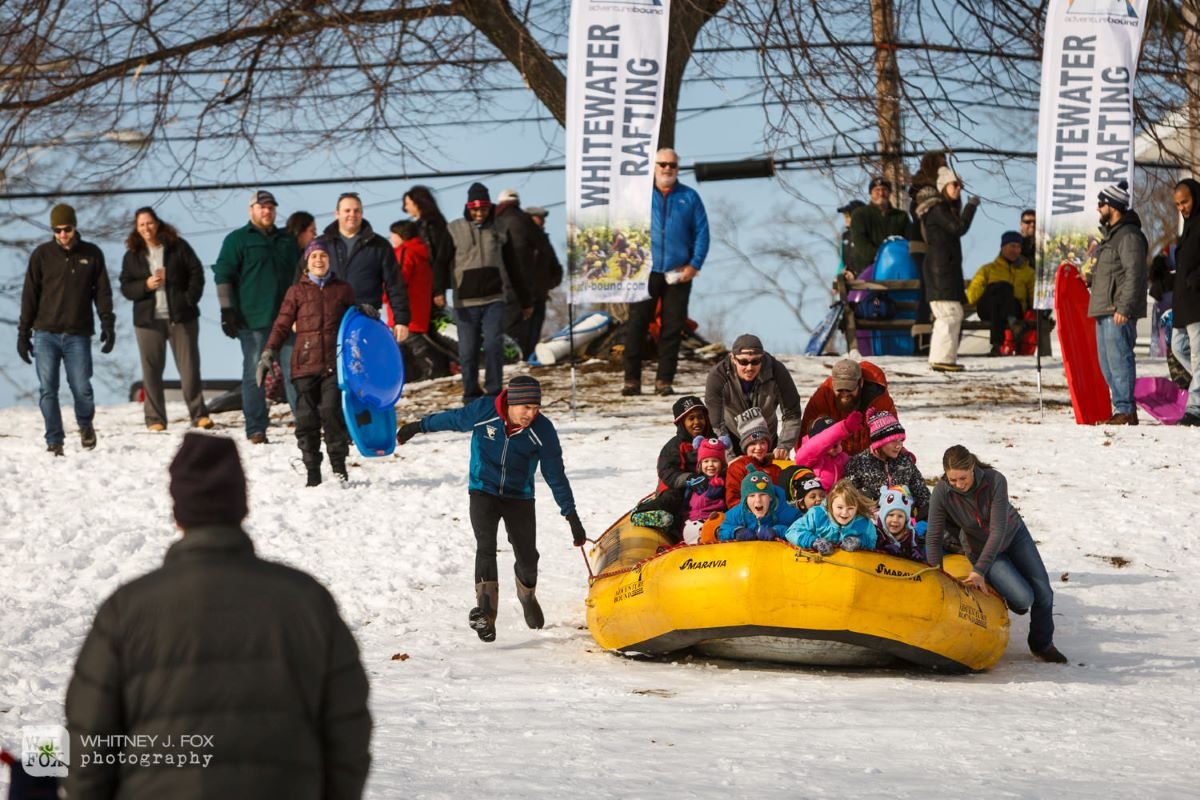Snow much fun!: Getting active during winter in Maine
By Amy Paradysz
The exhilaration of flying downhill. Finding flow across the ice. The light of the moon reflecting on snow. Quiet introspection in a landscape transformed by extreme weather.
The following nine stories of active Mainers anticipate a season that, as long as it may seem at times, is fleeting and precious. For these folks, winter is a time for playfulness. Exploration. Discovery. Connection. Camaraderie. Excitement. And joy.
But extreme weather is inherently harsh and hiking up a snowy mountain or traipsing across a frozen lake with ice fishing gear shouldn’t be solitary activities. Be sure you have the proper gear and the clothes for the activity and conditions. You’re likely to get sweaty, so dress in layers and stay hydrated. Play it safe, including checking ice thickness reports, wearing a helmet and knowing when to call it a day and head home.
Finally, never hesitate to ask for a little help from your friends. Exploring together is part of the fun!
Winter activities featured in this article: Figure Skating • Hockey • Snowshoeing • Winter Hiking • Nordic Skiing • Ice fishing • Sledding & Tubing • Snowboarding • Downhill Skiing
1. Figure Skating
Douglas Webster, Artistic Director of Ice Dance International • Kittery
Two-time U.S. National Champion Alyssa Czisny and Ice Dance International Artistic Director Douglas Webster lead a community class at Strawbery Banke Museum in Portsmouth, N.H. This winter they’re bringing classes to communities throughout Maine. For details: www.icedanceinternational.org. PHOTO: DAVID J. MURRAY/CLEAREYEPHOTO.COM
When Douglas Webster was growing up in North Conway, N.H., traveling to North Yarmouth and Augusta for ice time and coaching, he dreamed of being the best figure skating choreographer in the region. And—although “best” is a subjective and lofty word—it’s fair to say he made it. Capping a career with Disney on Ice, Ice Theatre of New York and ABC’s “Skating with the Stars,” Webster moved to Maine and co-founded Ice Dance International (IDI) in 2014.
That’s the short story behind how world- and national-champion skaters are performing and teaching this winter in several Maine towns, from Kittery to Doxer-Foxcroft. In partnership with L.L.Bean’s Winter Across Maine, IDI has planned popup events in Kennebunk, Portland, Freeport, Auburn, Rockport and Carrabassett Valley.
“The idea is to build opportunities for people to have first-time experiences with skating,” says Webster, who loves to share the joyous sensation of flowing across the ice. “The first thing we get them to do, of course, is bend and squat. And to fall down and get back up. One of the best things about skating is the life lessons you learn—to stand up on your own, to find balance, and to practice that when you make a mistake you keep going. The first thing you want to do when you step on the ice is find your balance. Then, understand how to transfer your weight. And then push. Skating is about bending, transferring your weight and pushing.”
Visit IDI’s website to learn about their pop-up events, community classes and repertory performances in Maine, New Hampshire and Vermot (many of them free, thanks to arts grants): icedanceinternational.org
Ice skating tip
Maine has dozens of outdoor ice rinks in the winter. Check out the Green & Healthy Maine roundup of outdoor skating rinks here.
Photo: Millinocket provided an otherworldly backdrop for Ice Dance International to film an artistic piece called “Solstice” last winter. PHOTO: DAVID J. MURRAY CLEAREYEPHOTO.COM
2. Hockey
Colin Petty • North Yarmouth
For Colin Petty of North Yarmouth, winter means hockey. Lots of hockey. PHOTO COURTESY TAMMIE PETTY.
One of the best parts of winter for Colin Petty, 16, of North Yarmouth is when his friends make a hockey rink in their backyard. Or he goes to Lee Twombly Pond, the refrigerated outdoor skating surface at Falmouth Family Ice that gets resurfaced a few times a day when the weather is right (and is free again this winter, thanks to sponsorships).
“Even without a stick or a puck, I’ve always loved going fast,” Petty says, adding that he started skating at age 3 and first picked up a stick at 4. Even more than ten years into playing competitive hockey, he continues to work with skating coach Kristin Andrews in Falmouth on power drills and hockey performance coach Alex Kurtz.
“If you can’t skate, you can’t showcase your skill when it comes to stick handling,” Petty says.
And showcasing his skills is big for Petty, who hopes to be scouted for a prep school team and, eventually, a college team. He plays center, enjoying that it’s both offensive and defensive.
Colin Petty on a team trip to Korea in 2018. PHOTO COURTESY TAMMIE PETTY.
Petty ’s family moved from Pittsburgh, Penn., to North Yarmouth in 2014, and he joined the Casco Bay Mariners as a Squirt (ages 9-10). Then, in fifth grade, he joined Maine Hockey Academy, playing teams from New Hampshire, Massachusetts, Rhode Island and Connecticut at a higher level. From 2018 to 2020, he played on the Seacoast Spartans in Exeter, N.H.
“We were getting along as a team, playing at a high level and winning a lot,” Petty says. “I love the competitive nature, playing for my team, coaches, parents and other people’s parents. And I love traveling with my team.”
Last year, he got the experience of being on a high school team, playing for Greely in Cumberland. But it was the one year that spectators weren’t allowed, due to pandemic precautions, and he missed the fans.
This year, he’s on the East Coast Spartans, based in Lowell, Mass., which involves seven hours of practice and six hours of games each week, not to mention travel time. This winter, he’s traveling with his team to showcases in Minnesota, Michigan, Pennsylvania and New Jersey as well as all over New England.
Hockey, Petty admits, can be pricey. But starting out doesn’t have to be. He recommends Play It Again Sports or community-based resale pop-ups for used equipment. Group Learn to Skate lessons that feed into hockey programs are offered by North Atlantic Figure Skating Club at Falmouth Family Ice; at Troubh Ice Arena in Portland; and by the Skating Association of Maine at The Bank of Maine Ice Vault in Hallowell, the Alfond Arena at University of Maine in Orono and Midcoast Recreation Center in Rockport.
At Learn to Skate classes, Petty says, you’ll make good contacts who you can ask about youth hockey programs or pick-up hockey for adults. And then you can take your skating skills—and your stick and your puck—outdoors. For ice reports for pond or lake skating, join the Facebook group Maine and NH Skating and Ice Report.
Hockey tip
The Alfond Youth & Community Center hosts an annual three-day pond hockey tournament at Messalonskee Lake (also called Snow Pond) in Sidney. Registration for a team of eight is $595 and participants must be 18 or older. There are divisions for all levels, including “just for fun.” Pre-pandemic, about 80 teams registered each winter, although last year it was “locals only,” with about 20 teams. Registration is open to teams from anywhere for the 2024 event, February 9-11, at Snow Pond Center for the Arts. For more info: mainepondhockey.org.
Photo: 2021 pond hockey tournament hosted by the Alfond Youth & Community Center. PHOTO: JOE LABBE.
3. Snowshoeing
Bill Yeo, L.L.Bean Community Engagement Coordinator
SNOWSHOEING PHOTOS COURTESY L.L.BEAN.
Bill Yeo doesn’t remember a time before snowshoeing, not if he can count riding on his father’s shoulders going through the Maine woods. Now the L.L.Bean community engagement coordinator for New England, Yeo is a former Outdoor Discovery instructor who had the chance to introduce many a group to his outdoor winter passion.
“It’s an affordable way to try out a new sport,” he says of the Outdoor Discovery program. “They supply all the equipment, and you get some instruction. A few little tips make a big difference in making the sport more efficient and enjoyable.”
Snowshoeing, Yeo says, is another way to explore Maine’s many nature conservancies, public land trusts and parks. And when the snow is deep, snowshoes will take you farther. Rather than thinking of winter hiking and snowshoeing as two different activities, Yeo heads out on a hike with his snowshoes tied to the outside of his backpack for when the terrain changes.
For snowshoeing, the equipment is fairly simple: the snowshoes themselves, bindings and poles. Recreational snowshoes are best for flatter terrain, while hiking snowshoes have better traction on slopes and have a heel lift to take stress off the calves. When it comes to bindings, Yeo says, “You want something that will hug and support your foot, so you’ll have more control.”
Poles, with baskets on them to prevent them from sinking into snow, take stress off the knees and help you maintain balance in uneven terrain. “You can also tap branches to get the snow off so it doesn’t go down your back,” Yeo says.
He wears a wicking layer, then a light- or medium-weight wool layer, topped off with a vest or a thin outer shell. L.L.Bean boots are his go-tos, of course, with gaiters to keep snow from spilling in over the top. He also wears a headlamp for nighttime snowshoeing.
“With the advent of LED headlamps, you can go explore even after work,” Yeo says. “If it’s a full moon, you might not even need a headlamp, especially with the light reflecting off the snow.”
Once you have this equipment, you can snowshoe all sorts of places for free. Just off the top of his head, Yeo cited the Falmouth Land Trust, Freeport Conservation Trust, Harpswell Land Trust, Portland Trails, Wells Reserve, or, for the slightly more adventurous, Bradbury Mountain State Park in Pownal or Black Mountain in Rumford. For ski centers in Maine where you can find snowshoe trails and equipment rentals, check the Ski Maine Association website.
“You can take it at any level you want, a half a mile or 20 miles or more,” Yeo says. “Generally, the slower you go, the more you are going to see. Or you can run. There’s a whole series of snowshoeing races.”
Snowshoeing tip
The Snowshoeing Discovery Course offered at L.L.Bean in Freeport is an all-equipment- included 1.5-hour introduction to the sport, offered December through March for $29.95 per person.
4. Winter Hiking
Joseph Brunette • Portland
Nick Sherman approaches one of the two distinct pointed peaks of Doubletop Mountain in Baxter State Park.
WINTER HIKING PHOTOS COURTESY @JOSEPH_BRUNETTE.
The White Mountains, which cover about a quarter of New Hampshire and continue into a small part of western Maine, have 48 peaks with elevations of more than 4,000 feet. To Joseph Brunette of Portland, that fact is all the challenge he’s needed to summit them all—and some of them more than once—over the 18 years since he moved to Maine.
“The snow and ice formations and extreme weather transform the landscape into something out of this world,” Brunette says. “At higher elevations, trees covered in snow and ice don’t even look like trees anymore. It’s unlike anything else you can experience anywhere else.”
Plus, he says, there are fewer people on the trails and no bugs.
“And in a lot of ways, coming down the mountain is easier on the body in the winter. You can step and glide,” Brunette says. Chuckling, he adds, “Or sit and slide. ‘Butt sledding,’ as it’s known.”
Butt sledding aside, going up a mountain takes a lot of cardio endurance, which is why Brunette starts running when the temperatures start dropping in the fall to get his body used to the cold, crisp air.
West Bond, a subsidiary peak of Mount Bond in New Hampshire.
If you’re new to winter hiking, go with someone more experienced and start with gentler slopes or a smaller mountain like one of those found in Maine’s western foothills. Hiram’s Mount Cutler (1,232 feet) offers a three-mile trail if you do the loop over the ridge and avoid the short but steep red trail. Brownfield’s Burnt Meadow Mountain (1,575 feet) has three trail options, including a 3.6-mile loop composed of the Burnt Meadow Mountain Trail (blue blazes) and Twin Brook Trail (yellow blazes). Either of these hikes would take a couple of hours round trip.
“With any mountain, you don’t always get to the top if you’re being responsible for yourself and your friends,” Brunette says. “Sometimes the weather changes and you need to turn around and go back. Prepare to be out there longer than you think you will be and bring a headlamp. Mountain weather can change quickly. And, with fresh powder, it can be more work and slower going up the mountain.”
When deciding how far to go and how long you’re out, consider how every person in the group is doing. Dress in layers. You’ll be sweating on the way up the mountain but don’t want to be wet when you’re at the summit, where it is colder and windier. Light snowshoes in a backpack provide another option for when the conditions change.
And bring some high-energy snacks and plenty of water. “It’s colder out and not superhot, so it’s easy to forget to drink water,” Brunette says. “But it’s just as important to stay hydrated as on a hot summer day.”
Winter hiking tip
Never hike a mountain alone, especially in the winter! Instead, connect with other hikers though organizations such as Maine Outdoor Adventure Club or Appalachian Mountain Club.
And be sure to bring proper safety gear for the conditions, which may be very different at the top of the mountain.
Photo: The first hikers up a mountain after a snow storm have to work harder because they are the first ones trudging through new snow or “breaking trail.”
5. Nordic (cross-country) skiing
Abby Johnston • Westbrook
Abby Johnston pauses for a photo while Nordic skiing at Sunset Ridge Golf Course in Westbrook. PHOTO: PAUL DRINAN.
Abby Johnston of Westbrook has fond memories of Nordic—or cross-country—skiing with her family when she was growing up in Massachusetts, and now she’s taught her own daughter to ski.
“Kids are naturals,” Johnston says. “They don’t have far to fall and tend to be fearless. Any child who is walking can Nordic ski.”
Many golf courses are open to cross-country skiing and some, like Riverside Golf Course in Portland and Lakewood Golf Course in Madison, even groom the trails.
Johnston’s go-to spot is Sunset Ridge Golf Course, an 18-hole course in Westbrook set on a landscape with woods and rolling hills. “We just pull into the parking lot, pop on our skis and go,” she says. “No charge. And it’s about seven minutes door to door.”
Out there, it’s easy to forget she’s within city limits. “We’ll see scat of different animals. It shows you that the space is shared, and you can be part of it and have that connection to the outdoors, seeing plants and trees in their dormant forms.”
Nordic skiing is also a cardio workout, a balance builder and solid work for the lateral muscles of the ankles and calves. It engages the whole body, including your arms.
“The poles are sort an extension of your arms and help propel you forward in tandem with your legs,” Johnston says. “You can move without them, but once you really get it you want the poles to maintain a rhythm. Poles help with balance, especially if going around a corner downhill.”
“Nordic skiing gives you a different perspective, even of places that may be familiar to you,” notes Johnston. “When there’s snow on the ground, you can navigate to places where you normally wouldn’t go.”
Nordic skiing tip
When looking for groomed trails and Nordic equipment rentals, the Ski Maine Association website is a helpful resource.
Photo: Nordic skiing at Mt. Blue State Park. PHOTO COURTESY MAINE BUREAU OF PARKS AND LAKES.
6. Ice Fishing
Richard Yvon, Maine Guide, Twin Maple Outdoors • Bradford
Maine Guide Richard Yvon of Bradford holds up a wild, native Maine lake trout caught in a Northern Maine glacial lake.
ICE FISHING PHOTOS COURTESY OF TWIN MAPLE OUTDOORS.
“Ice fishing, if you do it comfortably, is a relaxing way to enjoy the winter months outside,” says Richard Yvon, a licensed Maine Guide who takes small groups out on lakes north of Bangor from January through March when the ice is at least a foot deep.
Yvon supplies the traps, lines and lures and spiked safety shoes. He shows folks how it’s done, then they head into insulated, heated ice shacks where the holes are already drilled and ice chairs are set up. He even prepares a hot barbecue lunch, often with the potato wedges he’s dubbed Frontier Fries. And to take care of all the basic necessities, he hauls portapotties on the ice and back out again, following Leave No Trace principles.
“There’s a lot to consider in doing it right,” he says. “You have to learn the ethics, the laws, the whole life cycle and, definitely, safety. But I shorten the learning curve for people.”
First-timers are often stunned by the beauty of their surroundings and the surprising level of comfort and camaraderie. And then there are the fish themselves: perch, lake trout, whitefish and salmon.
But do they bite? Well, that depends on the day.
“It’s called fishing, not catching,” Yvon says. “On a good day, you catch a lot of fish. On a slow day, maybe one or two. But people learn a lot—as much as they want to know. We usually catch and release, but I let people keep fish when it makes sense to harvest, within the law. If it’s a big breeding lake trout, I’d let it go.”
Top Maine lakes for ice fishing are Moosehead, Sebago, Long, East Grand, Eagle, Portage and Allagash. The season is January 1 to March 31, and you need a fishing license. The Maine Department of Inland Fisheries & Wildlife has a thorough Beginner’s Guide to Ice Fishing.
The ice needs to be pretty thick; Yvon’s groups don’t go out on less than a foot of ice. Before you go out with an ice chisel and a jig, check Fishing Northeast or another website to find out approximately how thick the ice is at a particular lake.
Ice fishing tip
Maine Youth Fish & Game Association offers free annual youth ice-fishing days, typically twice a winter, at Pickerell Pond in Denmark (Oxford County). Visit their website for the latest info.
7. Sledding & Tubing
Julie Mulkern, WinterKids Executive Director • Gorham
SLEDDING & TUBING PHOTOS COURTESY WINTERKIDS.
“I grew up in Northern Maine, and when there was plenty of snow we couldn’t wait to get outside after breakfast,” says Julie Mulkern, executive director of WinterKids. “My cousins’ property was acres and acres in the forest with huge hills. We were always out tubing, tobogganing and sledding.”
Her boys—8-year-old Johnny and 5-year-old Benny—fly down the hills at the University of Maine in their hometown of Gorham and at Payson Park in Portland.
“And our yard has just enough slope for sledding,” Mulkern says. “It’s important to us that our kids be outside a lot.”
Since 2012, Mulkern has led WinterKids, the only nonprofit in Maine dedicated exclusively to increasing outdoor physical activity in children and families during our longest—and often most sedentary—season. As WinterKids’ executive director, she certainly knows sledding safety tips. For starters, wear water-resistant layers, including a jacket, boots, hat, and mittens or gloves. Don’t sled near fences, trees or light poles or in or near roads. Know your surroundings and make sure your “landing spot” isn’t rocky or too icy. When you go down the hill, go feet first, not headfirst. Sleds, tubes and toboggans can only hold so many people; piling on isn’t safe. For sledding in crowds, obey “traffic rules”: sled down the inside and walk back up the outside.
Sledding & tubing tip
You don’t have to own tubes—or even walk uphill—to go tubing at Seacoast Adventure in Windham or Eaton Mountain Ski Area & Snowtubing in Skowhegan.
8. Snowboarding
Ater Ater • Westbrook
Ater Ater of Westbrook grins as he steps out of his bindings at the bottom of a run. Originally from South Sudan, Ater struggled to explain snowboarding to his family. But his smile says it all. COURTESY PHOTOS.
When Ater Ater of Westbrook was a child in South Sudan, he never imagined he’d be an avid snowboarder. He’d never even seen snow before he immigrated to Maine, and when he tried it in college a decade ago and talked to his family about it, his experience got a little bit lost in translation.
“There’s no word for snowboarding,” Ater says, “so I had to describe as ‘ice go down mountain.’”
He started out fairly close to home at Shawnee Peak, a resort in Bridgton that offers discounted Monday nights under the lights—and similarly good deals can be found at Mt. Abram in Greenwood, Lost Valley in Auburn and Camden Snow Bowl.
Over time, Ater was ready to go longer—effectively the whole day, from 8 a.m. to 4 p.m.—and more often. And until this season when he turned 30, he was able to get a Nitro season pass for Sugarloaf (Carrabassett Valley), Sunday River (Newry) and Loon Mountain Resort (Grafton County, N.H.) that is about half the regular adult rate for anyone 29 or younger.
“Getting into the chairlift, I love looking behind me and seeing the beautiful view,” Ater says. “It’s one of my happy places. Being on top of the mountain is really peaceful. Going slowly—carving—is relaxing. And upping my speed, being a bit of a thrillseeker, can be exhilarating. Either way, it’s a full-body workout. And the more you do it, the more stamina you’ll have.”
For newbies, he recommends borrowing or renting equipment before investing in gear. And, if you’re able, practice putting on the boots, attaching the binders and getting up, down and back up again—before you’re whipping down a mountain. “Prepare yourself mentally by watching videos,” Ater recommends, noting that Youtube has instructions for all levels.
If possible, get instruction on the mountain. Or at least let a more experienced friend show you the ropes.
“Practice is key,” he says. “Don’t be afraid to start at the lowest point. The bunny slope might not seem like much, but to a beginner it can feel fast. If you see little kids passing you by, make sure to put your ego aside. If you’re going to fast for your ability, you won’t be able to control that speed.”
And sometimes you can’t control your speed anyway, if you hit a bumpy patch or lose an edge.
“Definitely wear a helmet, because your noggin is important and you’re going to fall a lot,” Ater warns. “Wrist guards or a butt pad or knee pads can be helpful. I’ve fallen multiple times in those areas. And dress in layers so that when you’re warm, you can downgrade.”
Snowboarding tip
Bring an extra set of clothes for a comfortable drive home after a full day on the mountain.
9. Downhill skiing
Aaron Lincoln • Camden
Downhill skiing is good family fun for the Lincolns of Camden. COURTESY PHOTOS.
Learning to ski was probably inevitable for Aaron Lincoln, living in Camden, which has the only ski area on the East Coast with ocean views. In the warmer months, as the owner of vintage sailing schooners, he’s out on Camden Harbor. But come winter, he works in the office at Camden Snow Bowl, where he sent his three kids to ski school. About a decade ago now, his middle kid pointed out that it was Dad’s turn to get on the mountain.
“I was surprised that I could learn to ski as quickly as I did,” Lincoln says. “I love the open space, whether I’m on a motorcycle or on a sailboat. And I like that you have to concentrate or you’re in trouble. I even love the really cold days—on the firm snow you can really go fast.”
At first, learning to ski in his 30s, he was afraid to fall.
“You put on a couple of slippery items and get on a slippery surface,” he says. “You’re going to fall. In fact, I fell over a few times just standing in line! One thing I was good at was falling and laughing every time.”
While you want to be mindful of safety, Lincoln points out that falling is actually safer when you don’t tense up—which means that having a sense of humor is a necessary piece of “equipment.”
These days, Lincoln says he spends a good amount of time with his family at Camden Snow Bowl. “It feels like a mom-and-pop ski area, though it’s owned by the town of Camden,” Lincoln says. “When you get off the ski lifts at the top, you’re looking at Penobscot Bay. There aren’t too many places where you can ski and see the ocean.”
By the end of his first season at Camden, he started skiing Saddleback and other Maine ski resorts, like BigRock (near Presque Isle), where he had “the best powder day ever.” The Lincolns have even skied in Quebec during February vacations. But it’s their hometown ski resort that started it all.
“Maine’s really lucky,” he says. “We have smaller mountains and larger mountains. I don’t know that I would have learned so quickly if I hadn’t had a small mountain so nearby. If it’s close, you’ll visit more often.”
Downhill skiing tip
Ski Maine Association lists resorts that offer lessons at skimaine.com/learn.


